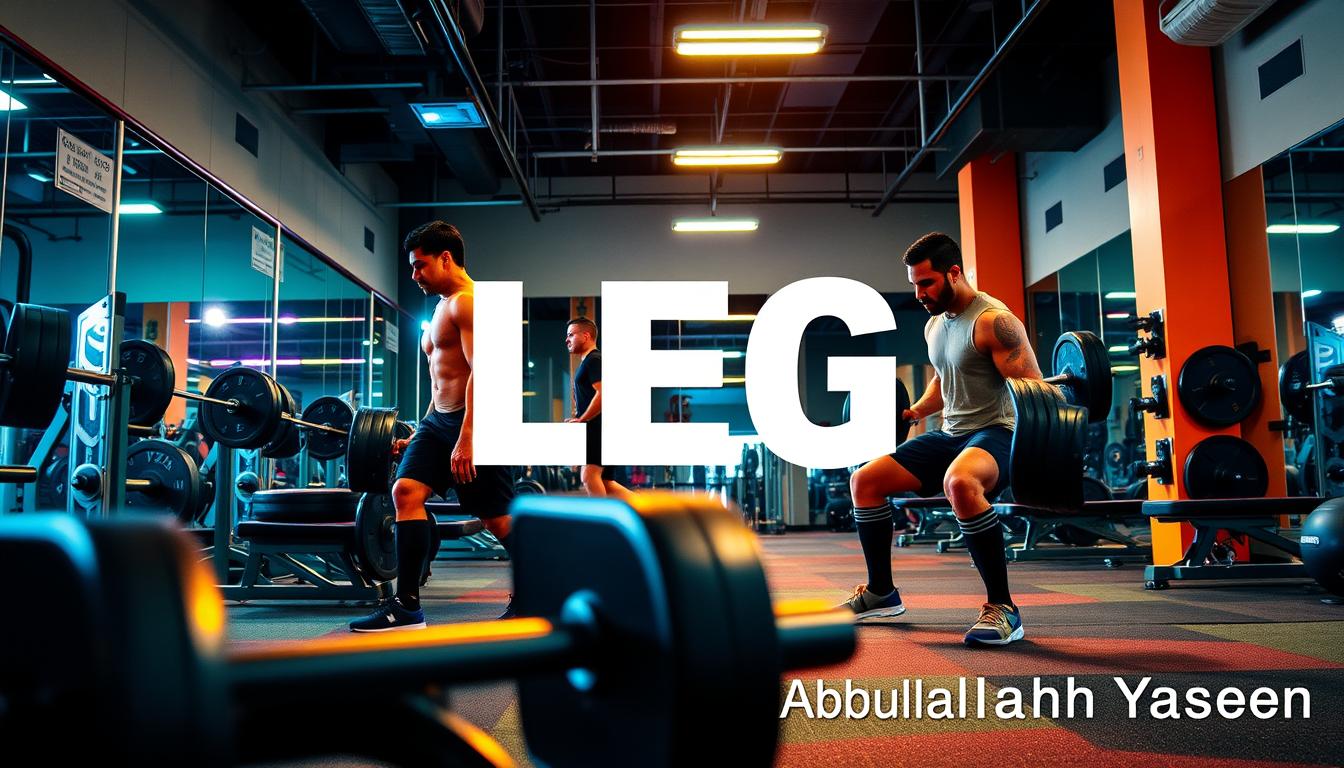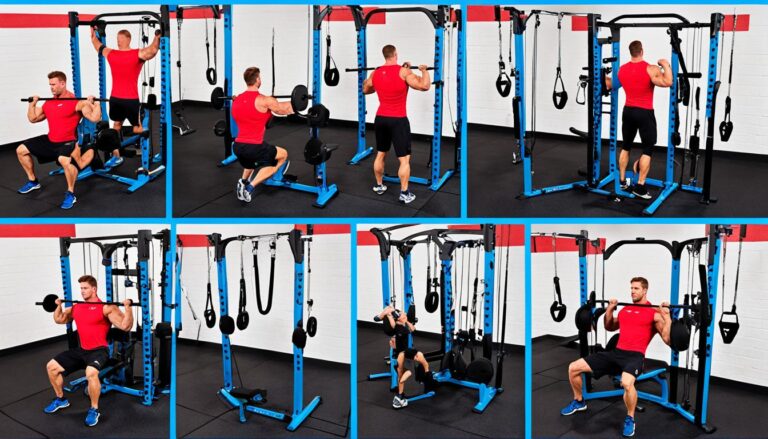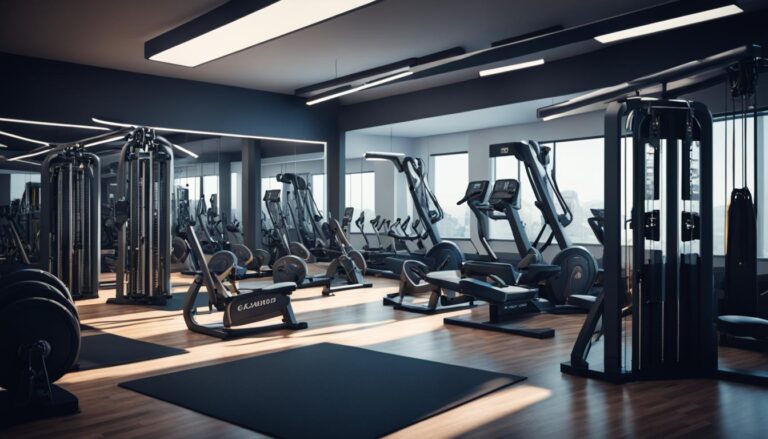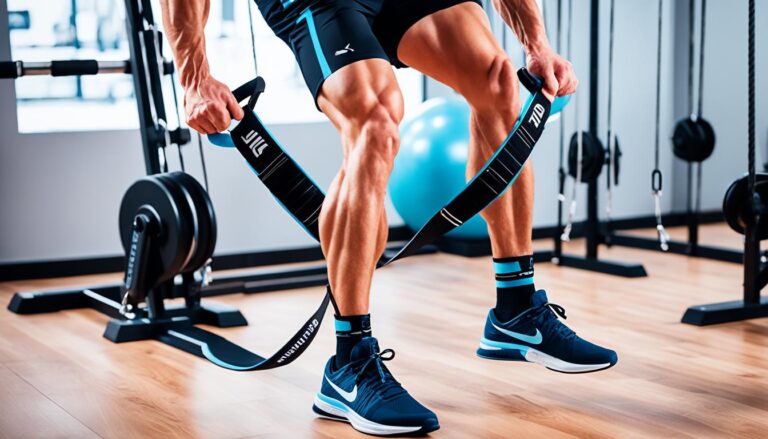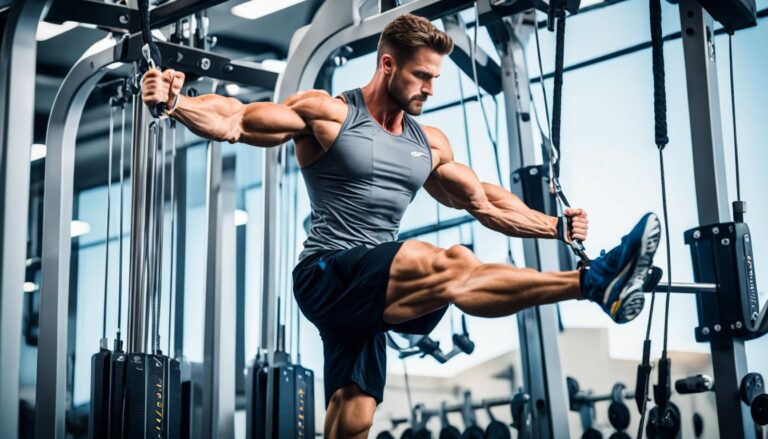You are about to read about some powerful Barbell Workouts for Legs.. The ultimate guide on powerful barbell leg workouts designed to build essential leg strength. I will dive into various exercises that form a comprehensive barbell leg workout routine, crucial for muscle growth and overall fitness. Whether you are new to powerlifting or looking to enhance your existing regimen, incorporating targeted leg strength exercises can make a significant difference.
Barbell workouts are not only effective for strengthening your legs but also play a vital role in your overall physical conditioning. They provide a balanced approach to muscle growth and help in building a robust foundation for other training activities. By following a structured barbell leg workout routine, you can achieve remarkable improvements in your fitness journey and powerlifting performance.
Key Takeaways
- Barbell leg workouts are essential for building leg strength and overall fitness.
- Incorporate varied exercises to target different leg muscles effectively.
- Consistent leg strength exercises lead to significant muscle growth and endurance.
- Proper form and technique are crucial to avoid injuries and maximize results.
- Ideal for both beginners and advanced powerlifting enthusiasts.
For detailed instructions and additional tips on effective barbell leg exercises, explore the full guide here. Additionally, to understand the significance of muscle isolation, especially for back exercises, you might want to check out this comprehensive article on cable machine workouts.
The Importance of Strong Legs
Having strong legs is crucial not only for athletes but for everyone. The benefits of strengthening leg muscles go beyond aesthetics, contributing significantly to overall physical fitness and well-being.
Benefits of Strengthening Leg Muscles
Strengthening your leg muscles is paramount to building functional strength. Exercises like squats and deadlifts are not just for bodybuilders; they promote muscle growth, enhance stability, and improve lower body muscles. These compound exercises engage large muscle groups, which in turn boost calorie burn. For more insights into the benefits of leg workouts, check out this Men’s Health article.
Impact on Overall Athletic Performance
Strong legs are the foundation of superior athletic performance. Whether you are a runner, a soccer player, or a basketball enthusiast, powerful leg muscles contribute to better speed, agility, and endurance. Moreover, robust lower body muscles help in preventing injuries by providing better support and stability during dynamic movements.
Boosting Everyday Mobility
Beyond sports, strong legs play a significant role in everyday mobility. Good leg strength ensures that routine activities such as walking, climbing stairs, and lifting objects are performed with ease and efficiency. This functional strength minimizes fatigue and reduces the risk of falls, making leg exercises a fundamental part of any fitness regimen.
Warm-Up Exercises Before Barbell Workouts
Proper warm-up exercises are crucial for optimal workout preparation and injury prevention. Engaging in dynamic stretching helps to increase blood flow to the muscles and enhance flexibility. By priming the body before a rigorous barbell workout, you can significantly reduce the risk of injury and improve overall performance. Below, I will outline some essential warm-up exercises to ensure effective and safe workout preparation.
- Leg Swings: Stand on one leg and swing the other leg forward and backward in a controlled manner. This movement aids in loosening the hip flexors and hamstrings.
- Lunges with a Twist: Perform a lunge and twist your torso towards the leading leg. This exercise engages the core and improves hip mobility.
- Arm Circles: Extend your arms out to the sides and move them in small circles, gradually increasing the size. This exercise is excellent for shoulder mobility and warming up the upper body.
Utilizing dynamic stretching thoroughly primes the muscles for heavy lifting. Ensuring adequate workout preparation with movements that mimic the exercises you’ll perform can greatly enhance your workout efficiency. Moreover, focusing on warm-ups also plays a critical role in injury prevention, which is essential for maintaining long-term fitness goals.
Here’s a comparison of recommended warm-ups:
| Exercise | Target Area | Benefits |
|---|---|---|
| Leg Swings | Hips and Hamstrings | Increases flexibility and range of motion |
| Lunges with a Twist | Core and Hips | Improves stability and mobility |
| Arm Circles | Shoulders | Warms up the shoulder joints |
Incorporating these exercises into your routine not only facilitates proper workout preparation but also embeds the foundation of a safe and effective strength training regimen. Warm-ups should never be overlooked, as they are essential for enhancing performance and ensuring longevity in your fitness journey.
Barbell Squats for Maximum Power
Mastering the barbell squat is essential for anyone serious about building leg strength and improving overall fitness. Whether you’re a beginner or an experienced lifter, understanding proper squat form and powerlifting techniques can help you maximize the benefits of this fundamental exercise.
Proper Form and Technique
When performing a barbell squat, it’s crucial to maintain proper form to avoid injuries and achieve optimal results. Here are some key steps to ensure you’re using the correct squat form:
- Stance: Stand with your feet shoulder-width apart and your toes slightly pointed outwards.
- Bar Position: Position the barbell on your upper traps or rear deltoids, depending on your preferred squat variation.
- Descent: Initiate the squat by bending at your hips and knees simultaneously, keeping your chest up and your back straight.
- Depth: Lower your body until your thighs are parallel to the ground or slightly below.
- Ascent: Drive through your heels to return to the starting position, making sure to keep your knees aligned with your toes.
Ensuring proper form and employing effective powerlifting techniques is essential for harnessing the full power of barbell squats.
Common Mistakes to Avoid
Avoiding common mistakes is vital for both safety and efficiency in your squat routine. Here are some errors to be mindful of:
- Arching the Lower Back: This can lead to serious injury. Maintain a neutral spine throughout the movement.
- Heels Off the Ground: Always keep your heels planted to ensure stability and proper force distribution.
- Knees Caving In: This indicates weak glutes. Focus on pushing your knees outward on both the descent and ascent.
- Inadequate Depth: Not reaching proper squat depth can reduce the effectiveness of the exercise. Aim for thighs parallel to the floor.
Variations of Barbell Squats
Incorporating different squat variations can add diversity to your workouts and target muscles differently. Here are some popular squat variations:
| Variation | Description | Benefits |
|---|---|---|
| Front Squat | Barbell positioned on the front shoulders | Engages more of the quads and core |
| Back Squat | Traditional barbell position on upper traps | Targets glutes and hamstrings |
| Box Squat | Squatting down to a box | Improves explosive power and control |
| Sumo Squat | Feet wider and toes pointed out | Focuses on inner thighs and glutes |
Exploring these squat variations will keep your workouts engaging while helping you continue to develop strength and improve squat form.
Leg Presses: Machine vs. Free Weights
When it comes to enhancing leg strength, both leg press machines and free weights offer distinct advantages. Knowing the differences can help you make an informed decision aligned with your fitness goals.
One of the key leg press benefits is its ability to isolate different parts of the leg muscles. This machine allows for a controlled movement pattern, reducing the risk of injury, especially for beginners. Additionally, the leg press machine supports your back and reduces strain, making it suitable for individuals with lower back issues.
On the other hand, free weights vs machines provide a different set of advantages. Free weight exercises, such as barbell squats or lunges, engage stabilizing muscles which can lead to improved overall functional strength. Free weights also offer a versatile workout regime, allowing a range of motion not typically possible with machines. This can be crucial for athletes aiming to enhance their athletic performance.
| Aspect | Leg Press Machine | Free Weights |
|---|---|---|
| Muscle Isolation | High | Moderate |
| Engagement of Stabilizing Muscles | Low | High |
| Risk of Injury | Lower | Moderate to High |
| Range of Motion | Fixed | Wide |
Ultimately, both the leg press machine and free weights have their own set of benefits. Consider your experience level, fitness goals, and any physical limitations to determine the best approach for your leg workouts.
Effective Deadlifts for Comprehensive Leg Strength
Incorporating deadlifts into your leg workout programs is essential for achieving comprehensive leg strength. With its emphasis on compound lifting, the deadlift not only enhances leg muscles but also improves overall stability and power.
The Importance of Deadlifts in Leg Workouts
Deadlifts are foundational in any efficient leg workout plan. They target multiple muscle groups simultaneously, promoting muscle growth, and enhancing core strength. By engaging the glutes, hamstrings, and lower back, deadlifts contribute significantly to compound lifting routines, offering benefits beyond just leg development.
Step-by-Step Deadlift Guide
Mastering the deadlift involves precision and correct technique:
- Starting Position: Stand with feet hip-width apart and grip the barbell with an overhand grasp. Keep the bar close to your shins.
- Lift Phase: Engage your core and drive through your heels to lift the barbell, keeping your back straight and chest up.
- Lockout: Stand fully upright with your shoulders back at the top of the lift, ensuring a stable, balanced position.
- Lowering: Reverse the motion in a controlled manner, bending at the hips and knees while keeping the bar close to your body.
Common Variations of Deadlifts
For those looking to enhance their leg workout programs, exploring deadlift variations can add diversity and target different muscle groups:
| Variation | Description | Benefits |
|---|---|---|
| Conventional Deadlift | The standard deadlift form, engaging the entire posterior chain. | Overall strength and muscle growth. |
| Sumo Deadlift | Feet are spread wider, with hands inside legs, reducing strain on the lower back. | Improved hip strength and reduced lower back stress. |
| Romanian Deadlift | Focuses on hinging at the hips with minimal knee bend, targeting the hamstrings more intensely. | Hamstring flexibility and strength. |
Targeting Calves: The Power of Calf Raises
Calf raises are a fundamental part of calf strengthening exercises and are crucial for anyone looking to enhance their lower leg workouts. This section delves into the nuances of standing versus seated calf raises, the numerous benefits of strong calves, and tips to maximize the effectiveness of calf raises.
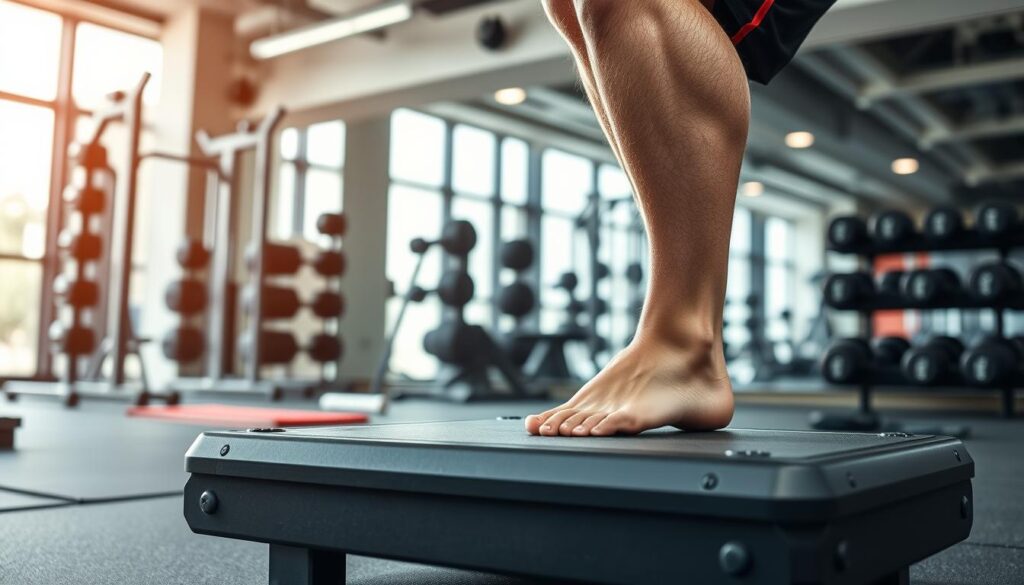
Standing vs. Seated Calf Raises
Standing calf raises primarily target the gastrocnemius muscle, which forms the bulk of the calf. This exercise is performed by standing on a raised surface with the heels hanging off the edge and lifting the body using the calf muscles. Seated calf raises, on the other hand, focus on the soleus muscle. This variation involves sitting with weights placed on the knees and raising the heels.
| Exercise Type | Targeted Muscle | Benefits |
|---|---|---|
| Standing Calf Raises | Gastrocnemius | Increases overall calf size, enhances explosive power |
| Seated Calf Raises | Soleus | Improves endurance, stabilizes lower leg |
Benefits of Strong Calves
Stronger calves contribute to better balance, increased ankle stability, and more powerful strides. This is particularly beneficial in activities like running, jumping, and various sports. Furthermore, well-developed calves can prevent injuries such as Achilles tendonitis and calf strains.
Tips to Maximize Calf Raises
To fully reap the benefits of calf raises in your calf strengthening exercises, it’s essential to follow these tips:
- Focus on Full Range of Motion: Ensure you’re lifting as high as possible and lowering as much as your flexibility allows.
- Utilize Progressive Overload: Gradually increase weights to continually challenge your muscles.
- Incorporate Variety: Include both standing and seated variations in your lower leg workouts to target different muscles.
- Pace Yourself: Slow, controlled movements engage the muscles more effectively than rapid repetitions.
By incorporating these strategies, you can significantly enhance your calf development and see better results from your lower leg workouts.
The Role of Lunges in Leg Strengthening
Lunges are a versatile and effective exercise that target multiple muscle groups, enhancing overall lower body conditioning. By incorporating different lunge variations, you can build strength, enhance core stability, and improve balance and coordination.
Different Types of Lunges
There are several lunge variations that you can include in your workout regimen to target different muscle groups and increase workout intensity:
- Forward Lunges
- Reverse Lunges
- Walking Lunges
- Side Lunges
- Curtsy Lunges
Perfecting Your Lunge Form
Proper form is crucial when performing lunges to prevent injury and maximize the benefits. Here are some key points to remember:
- Maintain an upright posture with your core engaged.
- Ensure your front knee does not extend past your toes.
- Keep your back straight and avoid leaning forward.
- Lower your body until your front thigh is parallel to the ground.
Benefits Beyond Leg Strengthening
While lunges primarily target the legs, they also offer several other benefits. Incorporating lunge variations into your routine can improve core stability and enhance overall lower body conditioning. Additionally, lunges help improve balance and coordination, which are essential for athletic performance and daily activities.
Romanian Deadlifts for Hamstring Focus
The Romanian Deadlift (RDL) is a pivotal exercise for anyone aiming to enhance hamstring exercises and reinforce posterior chain strength. Revered for its emphasis on the hamstrings, glutes, and lower back, this exercise is indispensable for improving overall athletic performance and preventing injuries.
When executed correctly, Romanian Deadlifts can significantly boost posterior chain strength. This compound movement not only targets the hamstrings but also engages the glutes and lower back, contributing to a stronger and more resilient lower body.
| Benefits | Description |
|---|---|
| Enhanced Hamstring Development | Focuses on the hamstrings for better muscle growth and endurance. |
| Injury Prevention | Strengthens the posterior chain, reducing the risk of injuries, especially in sports that demand explosive movements. |
| Improved Athletic Capability | Boosts overall power and performance, making athletes more efficient in their movements. |
Incorporating Romanian Deadlifts into your routine is straightforward. Begin with a light barbell to master proper form. One should focus on maintaining a slight bend in the knees, a straight back, and hinging at the hips to lower the barbell. This technique ensures the maximum efficacy of the exercise, directly benefiting hamstring exercises and posterior chain strength.
Hack Squats: A Mechanical Advantage
The hack squat is a powerful exercise that offers a mechanical advantage, making it ideal for those looking to focus on quad development. It stands out in the realm of squatting mechanics because it emphasizes the quads more directly than traditional squats. Let’s delve into how to perform hack squats, how they compare to traditional squats, and key safety tips to ensure you maximize the hack squat benefits.
How to Perform Hack Squats
To perform a hack squat, start by positioning yourself on the hack squat machine with your back firmly against the pad and shoulders beneath the pads. Place your feet shoulder-width apart and slightly forward on the platform. Unlock the safety handles and slowly lower yourself down by bending your knees until your thighs are parallel to the platform. Push through your heels to return to the starting position.

Comparing Hack Squats to Traditional Squats
| Feature | Hack Squats | Traditional Squats |
|---|---|---|
| Quad Engagement | High | Moderate |
| Stability Requirement | Low | High |
| Spine Loading | Minimal | High |
| Range of Motion | Fixed | Variable |
Hack squats provide a unique stimulus for quad development compared to traditional squats. They minimize spine loading and stability requirements, allowing for more focused engagement of the quads. However, traditional squats offer a greater range of motion and involve more overall muscle groups.
Ensuring Safety in Hack Squats
To ensure safety while performing hack squats, it is crucial to maintain proper form and control throughout the movement. Start with lighter weights to master the squatting mechanics before progressing to heavier loads. Always keep your back flat against the pad, avoid locking your knees at the top, and use the machine’s safety features. This approach will help you reap the hack squat benefits effectively and safely.
Barbell Hip Thrusts for Glute Activation
Incorporating barbell hip thrusts into your workout routine is an excellent strategy for maximizing glute engagement. This exercise not only targets the gluteal muscles but also enhances overall lower body strength, making it a crucial component of any comprehensive leg day regimen.
Importance of Strong Glutes
Strong glutes are essential for maintaining proper posture, improving athletic performance, and preventing lower back pain. The powerhouse of the posterior chain, glutes play a pivotal role in movements such as running, jumping, and lifting. Engaging in glute exercises like barbell hip thrusts ensures a balanced workout, contributing to both aesthetic and functional benefits.
Proper Form for Barbell Hip Thrusts
To perform barbell hip thrusts correctly, start by sitting on the ground with your back against a bench. Roll a loaded barbell over your legs until it reaches your hips. Keep your feet flat on the ground and shoulder-width apart. Engage your core, drive your hips upward, and squeeze your glutes at the top of the movement. The key is to maintain a straight line from your shoulders to your knees. Remember to lower your hips back down slowly and controlled. This hip thrust technique will help in maximizing glute engagement and minimizing the risk of injury.
Common Mistakes to Avoid
While barbell hip thrusts are highly effective, certain mistakes can hinder their effectiveness. Avoid arching your lower back excessively, as this can strain your spine. Ensure that your knees do not cave inward, maintaining alignment throughout the movement. Additionally, don’t rush through the reps. Performing the exercise too quickly can reduce muscle activation. Instead, focus on the quality of each rep to fully engage and activate your glute muscles.
FAQ
What should I include in my barbell leg workout routine for muscle growth?
To effectively promote muscle growth, your barbell leg workout routine should include exercises such as Barbell Squats, Deadlifts, Lunges, and Romanian Deadlifts. Incorporating variations and ensuring progressive overload in these exercises can significantly boost muscle mass.
Why are barbell squats essential for powerlifting?
Barbell Squats are fundamental to powerlifting because they target multiple muscle groups in the lower body, particularly the quadriceps, hamstrings, glutes, and calves. They are crucial for building leg strength and overall power, improving your performance in other powerlifting movements.
How do I properly warm up before doing barbell leg workouts to prevent injury?
It’s essential to engage in dynamic stretching and perform mobility drills as part of your warm-up routine. Exercises like leg swings, walking lunges, and bodyweight squats can help prepare your muscles and joints, reducing the risk of injury and improving your workout performance.
What are the benefits of strong legs for everyday mobility?
Strengthening your leg muscles enhances your functional strength, making daily activities such as walking, climbing stairs, and lifting objects easier and more efficient. It also contributes to overall balance and stability, reducing the risk of falls and related injuries.
Why should I incorporate leg presses into my workout, and how do they compare to free weights?
Leg presses are beneficial because they isolate the quadriceps, hamstrings, and glutes, offering a controlled environment to build strength. Compared to free weights, leg presses provide more stability, which is ideal for targeting specific muscle groups without the need for extensive balance or stabilization.
How important are Romanian Deadlifts for hamstring development?
Romanian Deadlifts are crucial for targeting the hamstrings and strengthening the posterior chain, which includes the glutes and lower back. This exercise helps enhance muscle balance, improve athletic performance, and prevent injuries related to hamstring weaknesses.
How does performing Barbell Hip Thrusts help with glute activation?
Barbell Hip Thrusts are highly effective for targeting and activating the glute muscles. By placing tension on the glutes through a concentrated range of motion, this exercise promotes muscle hypertrophy and strength, which are vital for overall lower body power and stability.
What common mistakes should I avoid when doing lunges?
Common mistakes include stepping too far or too short, leading to imbalance or poor muscle engagement, and allowing the knee to move past the toes, which can cause strain. It’s important to maintain proper form by keeping the core tight, torso upright, and controlling each movement to maximize the benefits.
Why do I need strong calves, and how can calf raises help?
Strong calves are essential for stability, balance, and overall lower body strength. Calf raises, whether standing or seated, help build calf muscle mass and power, which are crucial for activities such as running, jumping, and supporting heavy lifts.
What are the benefits of performing hack squats?
Hack Squats provide a mechanical advantage by emphasizing quadriceps development while reducing the strain on the lower back. They offer an effective alternative to traditional squats, particularly for those looking to enhance quad strength and muscle size.

